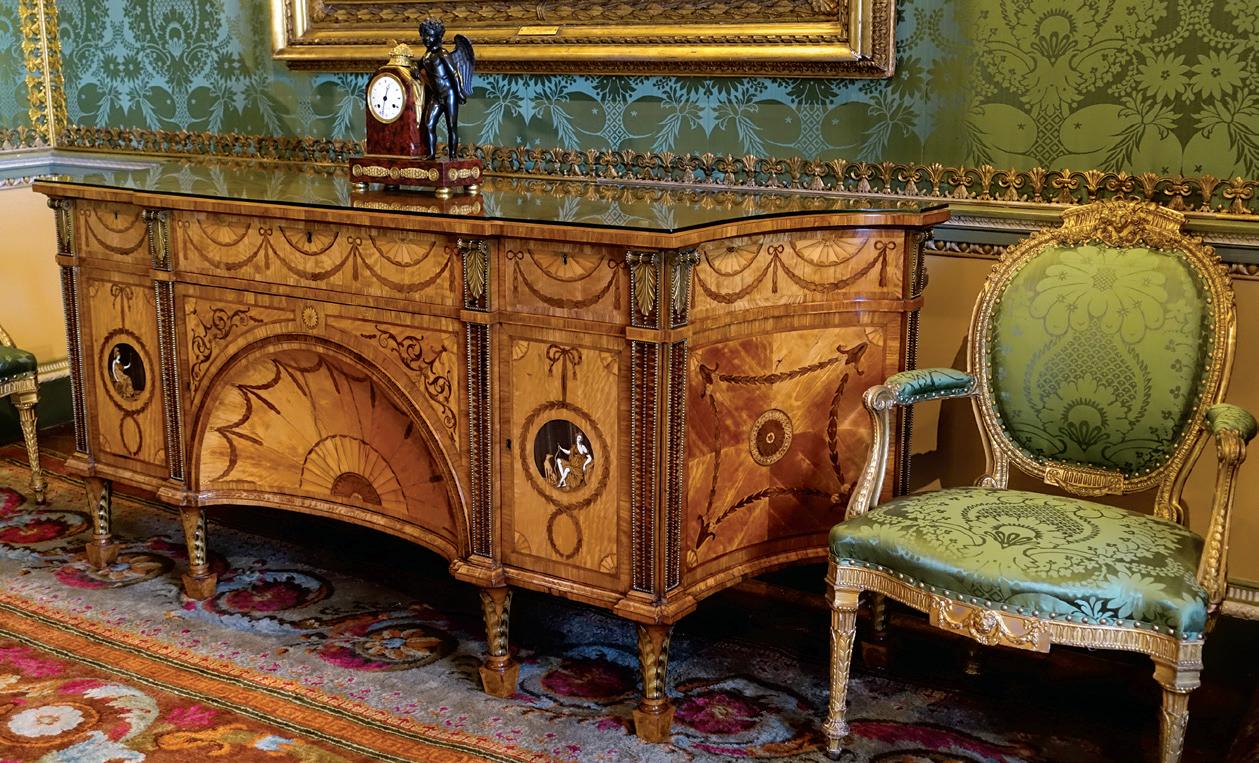
4 minute read
At Your Service
AT YOUR SERVICE THE DIANA AND MIVERVA COMMODE BY THOMAS CHIPPENDALE, 1773, IN THE STATE BEDROOM OF THE HAREWOOD HOUSE, WEST YORKSHIRE, ENGLAND. PHOTO COURTESY OF THE HAREWOOD HOUSE TRUST, WWW.HAREWOOD.ORG.
The long and beautiful cabinets that grace many dining rooms — or any room for that matter — had a very humble beginning. Whether you call them sideboards or buffets, they are one of the most versatile pieces of furniture you can own.
Advertisement
While the terms sideboard and buffet are used interchangeably, it’s generally accepted that sideboards have short legs or no legs at all, with cabinets or drawers to the floor, and buffets have slightly taller legs with similar storage. They evolved from small tables used for holding and serving food in late 18th Century Europe, and probably began as a simple plank supported by trestles on either end. The design was practical and served its purpose — until a better one came along.
It was Robert Adam, a Scottish architect and furniture designer, who traded the trestles for portable cupboards, convenient for storing serving pieces, flatware and linens. They became popular serving stations in the most fashionable dining rooms of the time. Adam went on to collaborate with Thomas Chippendale, creating ornate — while still utilitarian — pieces of furniture that were sought after as a nod to one’s social status. Their popularity grew in the 19th Century, with elaborate decoration in the form of inlays and veneers. They eventually became necessary pieces of furniture.
Around the same time, the French Commode was a cabinet or chest of drawers used in bedrooms, a style soon adopted by English cabinet makers. And a Welsh Dresser was the precursor to a China Hutch.
Nowadays, sideboards are perfect for storing fancier serving pieces, china and silver that are not used on a daily basis. Move them to another room and they become entertainment centers or bedroom dressers.
The flat tops are ideal for displaying treasured and decorative items. Whether your style is contemporary, farmhouse or you’re repurposing an antique, sideboards are a lovely — practical — solution in any home.
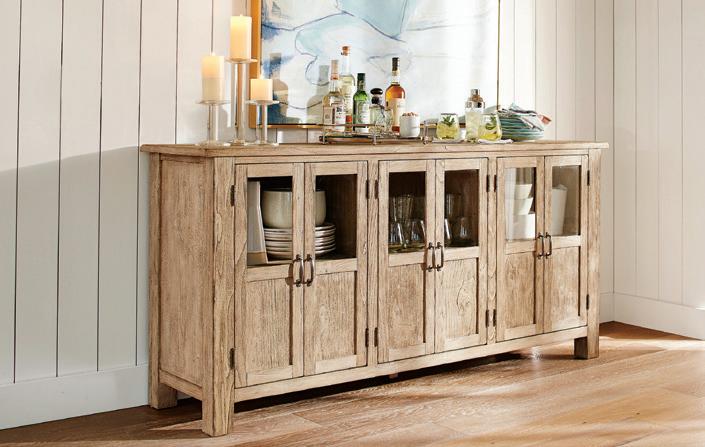
Tuscan TRADITION Built from kiln-dried sungkai wood and sungkai veneer, the Toscana Buffet contains a tempered glass front and adjustable shelves inside cabinet doors, ideal for storing essentials or the components of a media system: cutouts facilitate cord management. www.potterybarn.com
Dazzling DIAMONDS With its bold geometric pattern and mesmerizing optical appeal, the Black + White Bone Inlay Diamond Sideboard is the wow factor your dining space has been waiting for. Wrapped in sturdy, sleek metal, the doors open to reveal storage for dishes, platters and more. www.livingspaces.com

Modern ITALIAN With Porada, everything is born from the love of wood. This remains true for the Riga Sideboard with a frame in solid canaletto walnut. It is available in three or four-door options and multiple finishes, including lacquered colors, and with wood feet or a metal base. www.scottcooner.com
Classic CLOVER The Trefoil Sideboard blends inspiration from geometric textiles and nature’s classic clover — an eye-catching pattern that speaks to Tracey Boyd’s background in fashion design. Made from tiles of cross-hatched engineered oak veneer, a marquetry pattern features trefoil-shaped inlays of sapele wood in warm rosewood tones. www.fourhands.com

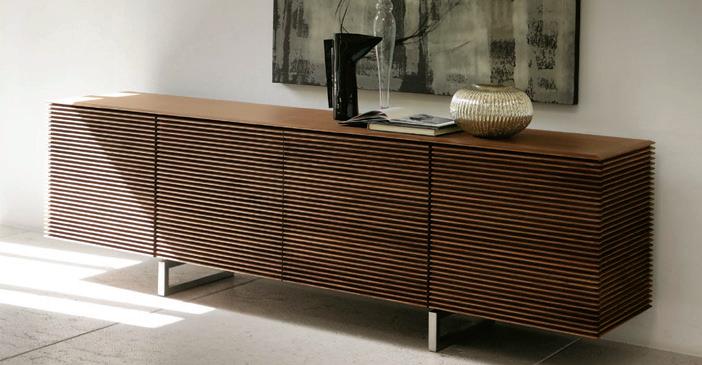
Dimple EFFECT Designed and handmade by Peter Glassford, the creation of the Dimple Cabinet in rosa morada wood with a natural lacquer is described by the artist as “slowly mistreated with a drill press” to achieve the lovely dimpling effect that accentuates the beauty of the wood; available in two sizes. www.peterglassford.com
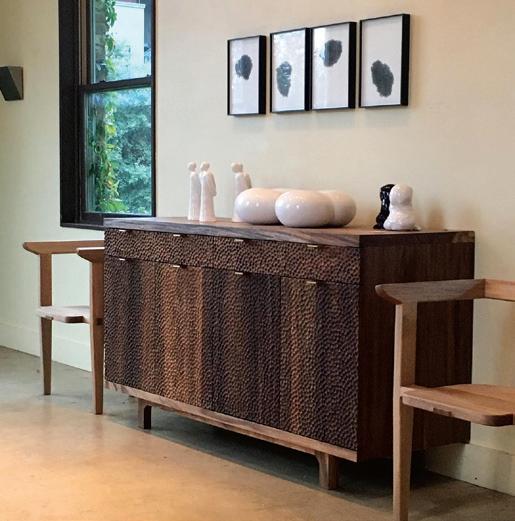

Silver LINING The Mackintosh Entertainment Credenza by Bernhardt features a tarnished German Silver clad case over meticulously carved reclaimed teak — a technique used in architecture and décor for more than 2,000 years. Behind each of the four doors are adjustable/removable shelves and ventilation holes in the back panels. www.stowersfurniture.com
Luxe LASER-CUT The Elements Quad Cabinet, designed by Jason Guidry and Louis A. Lara for BDI furniture, is a versatile storage console that combines form and function with ease. Shown in a charcoal finish and also available in natural walnut, the door panels are backed with perforated metal to conceal its contents, with three different laser-cut door patterns to choose from. The cabinet is four compartments wide, with a center compartment containing a storage shelf that accommodates most soundbar speakers. www.copenhagenliving.com
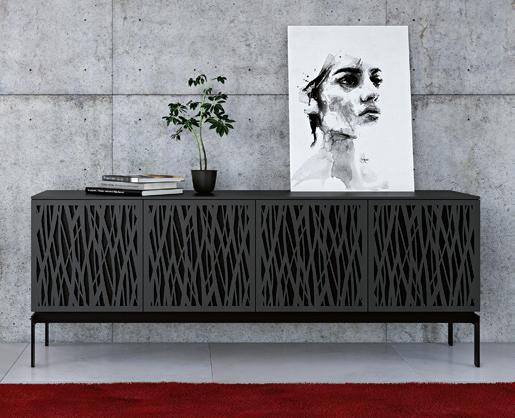

Gracefully GLOBAL Richly carved scalloped doors in antique gold and an espresso finish create a global texture with sleek contemporary lines. The Roma Server is great for serving a crowd or as a media center with cord management throughout. www.ballarddesigns.com u










